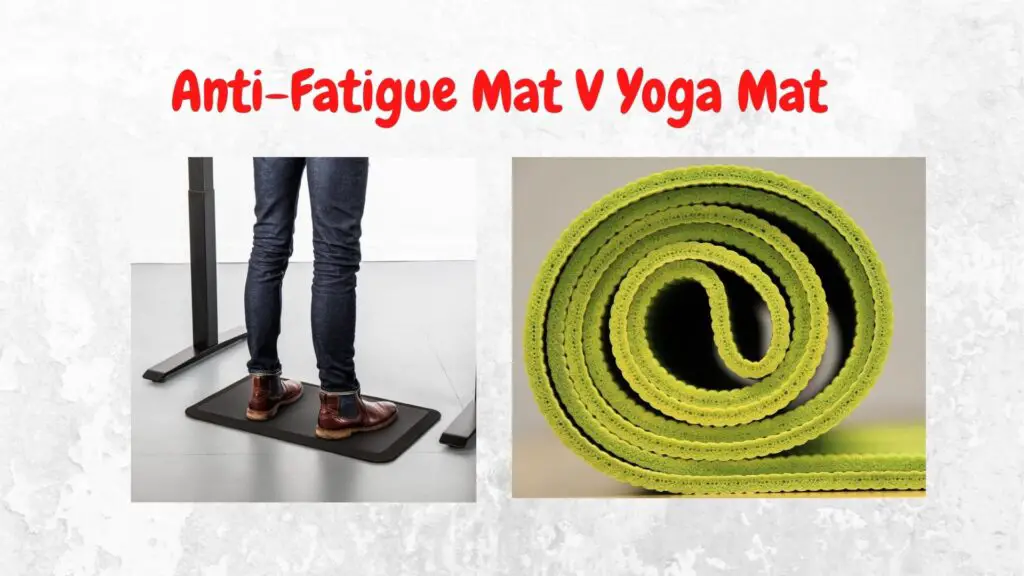Standing while working or completing activities is a necessity for many people. However, when you stand on a hard surface, it can lead to pain and fatigue. You might think up the idea of using a yoga mat if you don’t own a standing mat. But is that really the best solution? Let’s find out by comparing an anti-fatigue mat V yoga mat. This article critiques each based on 10 key factors to determine which is better. Stay tuned to find out which is best for you!
If you’re in a hurry, here is a site I recommended for office equipment with lifetime guarantee!
Anti-Fatigue Mat V Yoga mat
| Feature | Anti-fatigue mat | Yoga mat |
| Level of support | High | Low |
| Cost | $4 – $185+ | $4.39 – $299 |
| Safety features | Multiple | Few |
| Thickness | 0.375 – 1.25 inches + | 0.24 – 0.59 inches |
| Durability | High, suitable for work environments | Low, suitable for limited standing |
| Weight capacity | 300 pounds | None |
| Weight | 2.74 – 13.2 pounds | 1.81 – 26.46 pounds |
| Material | Multiple | Multiple |
| Size | Small, medium, large | Small, medium, large |
| Style | Limited functional design | Variety of colors |
Anti-fatigue mats help reduce foot and lower limb disorders in people who stand in one location for long periods. Source

Anti-Fatigue Mat V Yoga mat
Level of support
Anti-fatigue mats are designed to offer a high level of cushioning and shock absorption to enable you to stand for longer periods with less tiredness and discomfort.
In contrast, yoga mats are usually thin and lack the cushioning material that gives standing mats that ability to reduce fatigue.
Yoga mats may suffice if you are standing for short durations and you currently don’t experience any discomfort.
But in the long term, a standing mat will help to offset the effects of standing on your feet.
Cost
Anti-fatigue mats have a price range between $4 – $185+. In comparison, a yoga mat can start anywhere from $4.39 and reach prices as high as $299+.
The majority of the time, it will be cheaper to opt for a yoga mat instead of a comfort mat.
However, this monetary saving could come at a cost to your health, and comfort levels. Bear this in mind when deciding where your priorities lie.
If you need a bit of help with this, check out this article I wrote: Are Anti Fatigue Mats Worth It? 11 Unexpected Pros & Cons!
It’s clear that yoga mats won’t offer the same level of cushioning and support as an anti-fatigue mat.
Therefore, if you do require more support than a yoga mat can offer, you might suffer from fatigue, pain, muscle soreness and even varicose veins to name a couple.
Safety features
Anti-fatigue mats are designed for a range of work environments including:
- Homes
- Offices
- Kitchens
- Workshops
- Electrical workplaces
- Labs
- Cleanrooms
- Outdoors
To accommodate such environments, you can choose the safety features of the anti-fatigue mats based on the environmental conditions it will need to withstand.
Safety features that industrial anti-fatigue mats have include:
- Non-slip
- Chemical resistant
- Drainage built in
- Fire resistant
- Oil resistant
- Anti-static
With a yoga mat, there will be little to no selectable safety features. This might be ok if you only need some light cushioning when you stand at your office desk.
Furthermore, yoga mats generally are not suited to be used in environments where there is water, chemicals, hot objects, oil.
Plus, using it outside may cause damage to it if it gets torn.
But be warned that a yoga mat should at a minimum not pose a trip hazard or slide while you stand on it. Some mats have a tendency to curl up at the edges, especially if they are rolled up for storage.
Tip: Look for an anti-fatigue mat with beveled edges to minimize the risk of tripping over it.
Thickness
Anti-fatigue mats come in an array of thickness levels, starting from 0.375 inches and ranging as thick as 1.25 inches +.
The extra padding offers you a greater level of cushioning. However, choosing too thick of a mat could make using the standing mat a bit of a balancing act.
Yoga mats have a range of thickness levels, but on a far smaller scale than fatigue-reducing mats.
The average thickness of a yoga mat ranges from 0.24 – 0.59 inches.
Plus, the material that yoga mats are made of makes them liable to sinking under your weight, whereas anti-fatigue mats are designed to be durable to this pressure.
Durability
Anti-fatigue mats are designed with different levels of durability. It tends to be based on the amount of time that the standing mat will be used for. This means that they should be suitable for places where they will be used even for long hours throughout the day.
| Type of anti-fatigue mat | Duration of use | Environment suited to |
| Light duty | < 4 hours a day | Office, reception |
| Medium duty | 4 – 6 hours a day | Kitchen, office |
| Heavy duty | > 6 hours a day | Kitchen, workshop, assembly line, outdoors |
The fatigue-reducing mat should return to its original shape quickly as you shift your weight off it.
This is an important factor to look for when choosing a quality anti-fatigue mat.
Anti-fatigue mats can also be resistant to spills, stains, hot objects, chemicals and punctures.
In general, anti-fatigue mats have a lifespan of around 2 years.
However, if you opt for the Safco Movable Anti-Fatigue Mat, you can get a lifetime warranty.
In contrast, yoga mats have a lifespan of just 6 – 12 months.
In addition, yoga mats are not designed for being stood on. Therefore, using them as a standing mat may further shorten their life.
It ultimately depends on the quality of the materials used and how often you use the mat.
That said, if you do require a more durable yoga mat, opt for one that is denser as opposed to thick.
You can also consider a Manduka yoga mat which offers an impressive warranty of 10 years on yoga mats used frequently.
However, the yoga mat warranties often have caveats which don’t cover day to day wear and tear.
Tip: Pay close attention to what’s covered in yoga mat wear warranties.
Weight capacity
When purchasing an anti-fatigue mat, you’ll notice that there is a weight limit provided. This indicates how much pressure the standing mat can withstand without becoming subject to sinking or damage.
Anti-fatigue mats can hold weights as high as about 300 pounds.
In contrast, I have never seen a weight limit for a yoga mat.
Weight
Both standing mats and yoga mats are relatively light.
Anti-fatigue mats have weights starting around 2.74 and can reach weights up to 13.23 + per m2.
Obviously if you’re investing in a large strip of industrial anti-fatigue matting, this will weigh more than a standard sized mat.
Yoga mats generally weigh around 1.81 pounds. One of the largest yoga mats I have come across weighs 26.46 pounds.
Material
Both standing mats and yoga mats have an array of materials to choose from.
Anti-fatigue mats are generally made from polyurethane foam, gel, vinyl or rubber which are durable materials with cushioning properties.
High density memory foam is a popular choice for anti-fatigue mats.
Yoga mats are made from a variety of materials including:
- Vinyl (also known as PVC)
- Rubber
- Cotton
Tip: There are some eco-friendly yoga mats made of recycled rubber.
Size
Standing mats are available in compact sizes suitable for standing one person on. Small sizes start around 17 x 24 inches while larger standing mats measure in around 24 x 70 inches.
They can range all the way up to rolls which are suited to workshops or more industrial environments.
Yoga mats are also available in small sizes starting at 24 x 60 inches and ranging up to 78.74 x 51.97 inches.
They also tend to come in a greater variety of sizes and shapes, whereas anti-fatigue mats tend to be only square or rectangular.
Style
Anti-fatigue mats tend to be designed with functionality and safety in mind. They are generally sold in a dark color and have limited design features, particularly with industrial anti-fatigue mats.
Yoga mats are also generally low-key in terms of style but they do have a wide range of colors.
Can you use yoga mat as anti-fatigue mat?
Yoga mats can be used as an alternative to fatigue-reducing mats. They will offer some light level cushioning compared to standing on a hard floor. However, since yoga mats are generally thinner, they are unlikely to offer as much support and cushioning as a standing mat.
Yoga mats often lack a non-slip surface which means they could slide under your feet, especially if placed on a polished or low-grip floor.
That said, this could be remedied by using an anti-skid grip pad, such as the GelPro GellyGripper.
The same could be said for anti-fatigue mats that slide. However, you could just purchase a non-slip anti-fatigue mat or non-slip yoga mat in the first place to eliminate this risk.
Related: Balance boards vs anti-fatigue mat – cheat sheet included
Conclusion
As you can see, the anti-fatigue mats triumph over yoga mats in practically every feature.
Standing mats are without a doubt more effective than yoga mat at providing comfort and support while you stand.
However, if very light cushioning, aesthetics and coziness are your key priorities, then a yoga mat might just do the job!
If you’re still not sure or would like further dive into the many benefits of anti-fatigue mats, I have written some articles worth a look.
Here are some other useful articles I wrote that you should go check out:
- Balance board vs anti-fatigue mat – cheat sheet included
- How do anti-fatigue mats work? With FAQs
- How to choose an anti-fatigue mat – 16 essential factors
- Anti-Fatigue Mat V Carpet – A Quick & Simple Comparison!
- 7 Anti-fatigue Mat FAQs – Surprising & Helpful Answers!
Recommended products:
